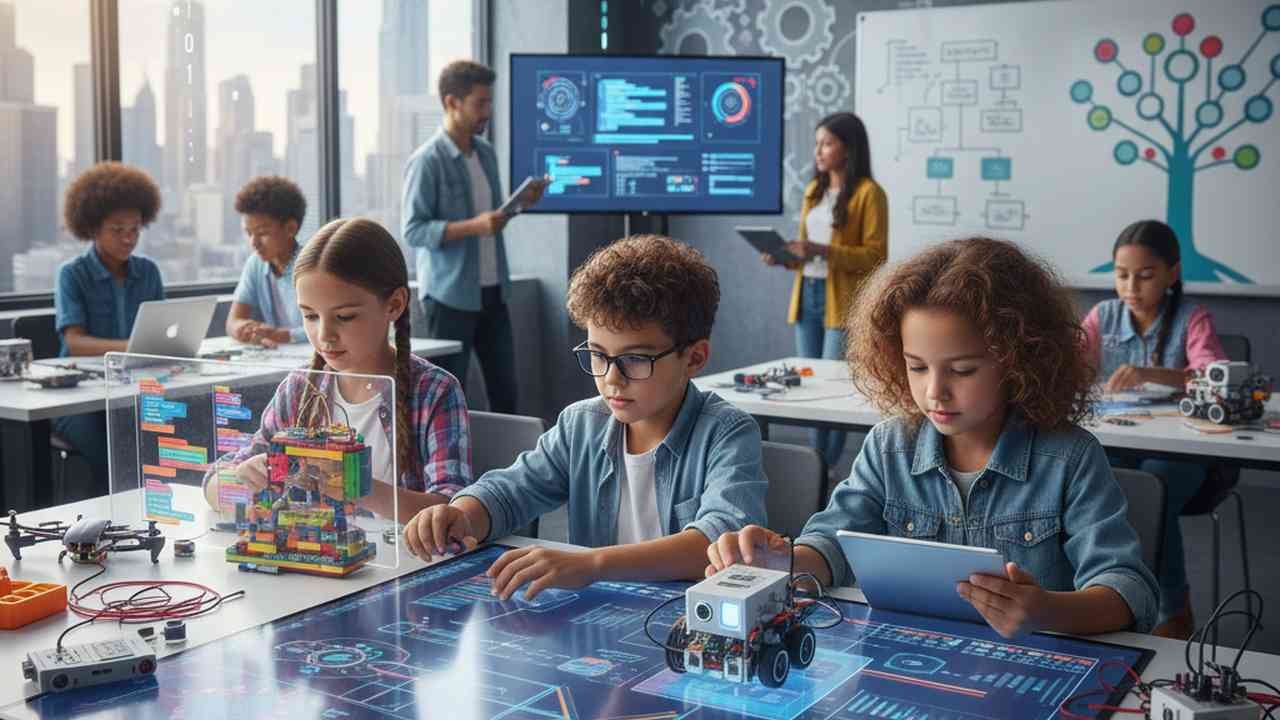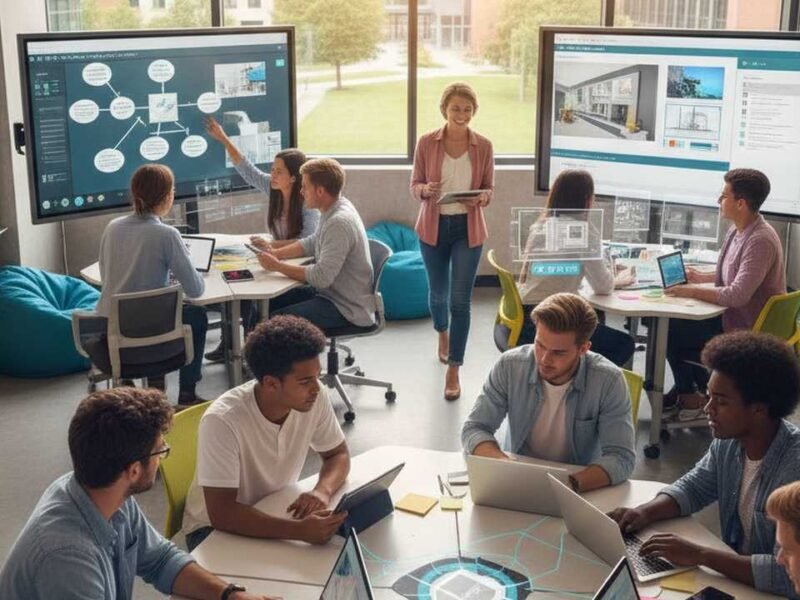The Urgent Need for STEM Education in Today’s Fast-Paced World
The world is moving at an unprecedented speed, and nowhere is this more evident than in the rapidly evolving landscape of technology. Every moment spent without equipping young minds with coding, computational thinking, and STEM skills is a lost opportunity, a step behind peers who are seizing the future. Imagine a classroom buzzing with the hum of computers, students’ eyes wide with the thrill of creating their first program, fingers flying across keyboards, and the satisfaction of seeing abstract logic transform into tangible results. This is not a distant fantasy – this is the reality on educated paths to success. Parents, educators, and mentors are beginning to realize that early exposure to these skills dramatically increases problem-solving abilities, cognitive flexibility, and innovation. Data from the U.S. Bureau of Labor Statistics indicates that STEM-related careers are projected to grow at double the rate of non-STEM careers, yet many schools still lag in providing high-quality, hands-on experiences. Missing out now could mean watching your students or children struggle to catch up in a competitive job market just a few years down the line. The urgency is real, palpable, and immediate.
Immersive Coding Experiences: More Than Just Typing Lines of Code
Learning to code is not just about memorizing syntax or following rigid tutorials; it is an immersive, sensory-rich adventure that shapes the way students think and create. Visualize a classroom where each child interacts with vibrant, drag-and-drop programming interfaces, constructing games that respond to their commands, seeing logic come alive in colors and motion. This hands-on engagement cultivates both persistence and creativity. On educated approaches, instructors integrate real-world applications, guiding students to create programs that solve problems they care about, whether it’s designing a virtual ecosystem or simulating a roller coaster ride. The tangible thrill of watching code execute perfectly after hours of debugging instills a sense of accomplishment that traditional methods cannot match. Parents and educators who have adopted these immersive methodologies report higher retention, improved logical reasoning, and increased enthusiasm for STEM subjects. The key is to avoid passive learning and instead immerse learners in environments where experimentation is not just allowed but encouraged, creating a sense of urgency to dive in now before opportunities slip away.
Computational Thinking: Building a Foundation for Lifelong Problem-Solving
At the heart of coding and STEM lies computational thinking, a structured approach to breaking down complex problems into manageable parts, recognizing patterns, and developing algorithms. This skill is essential for any on educated strategy that aims to future-proof a learner’s cognitive abilities. Imagine guiding students through a maze, encouraging them to identify recurring patterns, strategize solutions, and predict outcomes – these exercises mirror real-world decision-making. In today’s competitive climate, those who master computational thinking early have a distinct advantage, able to dissect challenges with clarity and precision that others lack. Educators worldwide emphasize that integrating computational thinking across subjects – from math to science to humanities – enhances analytical reasoning, creativity, and adaptability. Real-world case studies show that students who engage deeply with these methods excel in standardized tests, programming competitions, and collaborative problem-solving projects. The FOMO is undeniable: every day without these experiences is a missed chance to instill skills that will define academic and career trajectories.
Project-Based Learning: Turning Theory into Tangible Achievements
Project-based learning (PBL) is the bridge between abstract theory and concrete, observable success. In a PBL-focused classroom, students are not simply consuming information – they are creators, innovators, and problem solvers. Imagine a room filled with the scent of electronics, the rhythmic click of keyboards, and the excited chatter of students as they assemble robots, develop mobile apps, or simulate real-world systems. This tactile engagement ignites curiosity and reinforces learning in ways that traditional lectures cannot. On educated initiatives, PBL aligns with real-world scenarios, ensuring that students’ work mirrors industry practices, thereby enhancing employability and practical understanding. Research from MIT and other leading institutions confirms that project-based learning significantly improves retention, critical thinking, and student confidence. By embracing this approach now, educators and parents can ensure that learners are not left behind while peers elsewhere gain an experiential, market-ready advantage.
Gamification and Interactive Learning: Motivation Through Play
Human beings are wired to respond to challenges, rewards, and playful competition, and gamification leverages this innate drive to supercharge learning. Consider a digital coding platform where students earn badges, unlock new levels, and compete in coding duels, their excitement palpable as they track their progress in real time. This approach transforms potentially intimidating subjects into thrilling adventures, lowering barriers to entry and fostering a deep, enduring engagement. On educated approaches, gamification is integrated thoughtfully, ensuring that the mechanics of play reinforce learning objectives rather than distract from them. Verified reports from educational technology platforms highlight that students exposed to gamified learning show higher persistence, increased participation, and stronger problem-solving capabilities. Failing to implement these engaging methods today risks leaving students in the dust, watching their peers develop essential skills while they struggle to catch up, intensifying the sense of urgency and FOMO for every educator and parent committed to excellence.
Mentorship and Peer Collaboration: Learning in a Social Ecosystem
Learning in isolation limits potential; collaboration magnifies it exponentially. When students engage in peer coding sessions, collaborative STEM projects, or mentorship programs, they gain access to diverse perspectives, feedback, and encouragement that accelerates their development. Picture a dynamic workspace where older students mentor younger ones, code reviews generate animated discussions, and breakthroughs are celebrated as a community. On educated programs, mentorship is structured with clear milestones, verified guidance, and responsive support, ensuring that every learner has access to expertise and encouragement. Industry experts from organizations such as Code.org and the STEM Learning Center confirm that mentorship and peer collaboration not only enhance skill acquisition but also build resilience, communication, and confidence. The FOMO is real: opportunities to learn in such enriched social ecosystems are finite, and missing them means losing out on transformative growth experiences that textbooks and solitary practice cannot replicate.
Integrating Real-World Technology: From Simulation to Application
Exposure to real-world technologies bridges the gap between learning and practical application. Imagine students programming drones to navigate obstacle courses, simulating smart home devices, or analyzing datasets that mirror actual industry challenges. On educated pathways, these experiences are meticulously curated to ensure safety, security, and relevance, with responsive customer support available to address any technical issues. Verified studies demonstrate that hands-on interaction with current technologies enhances retention, hones technical skills, and inspires learners to pursue STEM careers. For instance, robotics competitions and coding hackathons allow students to measure their learning against tangible outcomes, providing a visceral sense of accomplishment. Delaying such experiences risks creating a generation of learners who are technically aware but unprepared for the rigor and creativity of real-world problem-solving. The urgency is palpable: every missed opportunity diminishes a learner’s ability to thrive in a technology-driven future.
Early Exposure and Continuous Practice: Creating Lifelong Learners
Research consistently shows that early exposure to coding and STEM concepts produces lasting cognitive benefits, from improved logical reasoning to enhanced creativity. On educated programs, this exposure is combined with continuous practice, scaffolding increasingly complex challenges that grow with the learner’s abilities. Envision children exploring interactive simulations, debugging programs, or constructing miniature engineering projects daily, their understanding deepening with each success and failure. Verified educational studies indicate that continuous, iterative engagement fosters mastery far more effectively than sporadic, isolated lessons. FOMO intensifies when considering that students who miss early exposure may face steeper learning curves later, struggling to catch up to peers who have consistently cultivated these skills. Parents and educators who recognize this are rapidly adopting structured, hands-on curricula to ensure that learners gain both competence and confidence, securing a critical advantage in academic and career success.
Leveraging Industry Insights and Verified Resources
Integrating insights from trusted industry sources, verified educational platforms, and licensed content ensures that students are learning skills that matter and are recognized globally. On educated approaches, lessons are informed by current trends, expert contributions, and real-world applications, ensuring that knowledge is both practical and marketable. Imagine a learning environment where content is dynamically updated, instructors provide verified feedback, and resources include secure, licensed software tools that reflect industry standards. Verified case studies reveal that students trained with this model exhibit superior problem-solving abilities, adaptability, and readiness for competitive STEM careers. Delaying adoption risks leaving learners with outdated or irrelevant skills, magnifying the FOMO for parents and educators eager to provide meaningful, future-proof education. Now is the moment to act decisively, investing in methods that ensure learners are equipped to excel in an ever-changing technological landscape.
Call to Action: Secure Your Learner’s Future Today
The window of opportunity is narrow, and the stakes could not be higher. On educated pathways, every moment spent hesitating is a missed chance to provide learners with the tools, mentorship, and experiences that will define their futures. Parents, educators, and learners themselves must act now to embrace immersive coding programs, computational thinking exercises, and STEM skill-building initiatives. Platforms with verified payouts, responsive support, and licensed content offer tangible, reliable pathways to success. Imagine your child or student not just surviving in a tech-driven world but thriving, confident, and empowered to innovate, problem-solve, and lead. Sign up today to access proven programs, real-world mentorship, and hands-on experiences that are transforming learners into future-ready innovators. The urgency is undeniable, the opportunity fleeting, and the FOMO real – act now to secure an educated, empowered future.


